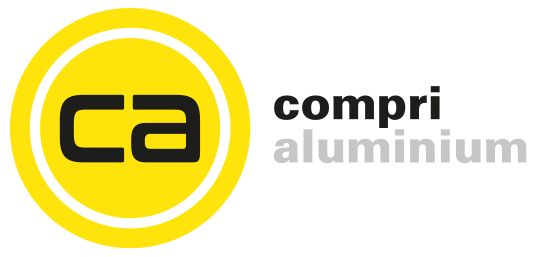Aluminium
Mining
Bauxite, the ore form of aluminium, consists mainly of A1203 (aluminium oxide).
Bauxite covers approximately 8.5% of the earth’s surface. This makes aluminium the most abundant element on earth, after oxygen and silicon.
The bauxite is brought into contact with warm caustic soda. The caustic soda reacts with the aluminium oxide that is present in the bauxite, forming sodium aluminate. The remaining components of the bauxite settle and are filtered so that a pure hydroxide remains.
The sodium aluminate is then cooled so that the aluminium hydroxide crystallises and the caustic soda remains. The aluminium hydroxide is heated (calcined) and this is how aluminium oxide is formed, which is also called alumina.
Production
The aluminium oxide powder (alumina) is heated together with cryolite. A direct current is fed into the liquid when at 1000 degrees Celsius. In the meantime, the alumina has dissolved in the cryolite and is split again using electrolysis, releasing liquid aluminium and oxygen. The liquid aluminium is then transferred and transported to the foundry. There, it is cleaned and mixed with other materials if required (depending on the quality of aluminium required). The mixed aluminium is made into rolling slabs and extrusion bars. These extrusion bars and rolling slabs are the basis of most aluminium products.
4000 kg bauxite can produce around 1000 kg of aluminium.
Properties
Alloy
Compri Aluminium supplies various alloys, all with several properties in common. This quality of aluminium is non-alloy. The material is not heat-treatable. Increasing the strength of the material is only possible through cold forming, which results in reduced flexibility and malleability. The corrosion resistance under ‘normal’ conditions is excellent and can be improved through technical anodising if necessary. This alloy is perfectly malleable when in annealed form.
Corrosion
Pure aluminium and the alloys that do not contain copper have excellent properties in many environments. This is why the copper-free alloys are mostly used in the construction world. Other industries also use aluminium regularly; aluminium alloys are an inextricable part of daily life. One of the reasons for this is the corrosion resistance of the material. Different alloys are used in various environments. In order to increase the resistance against corrosion, one example is to use a surface treatment.
Surface treatments
Aluminium can be treated in many different ways. However, the construction industry only uses two surface treatments, Namely anodising and muffling. When anodising, the oxide layer (naturally present on the material) is strengthened.
When powder coating, the aluminium is chemically cleaned and degreased first. Then it is electrostatically charged. When the charged aluminium is sprayed with the negatively charged powder, the powder adheres to the products. The material is then placed into a drying oven where the powder is converted into a very strong coating.
Malleability
Aluminium is very strong, but also very malleable under the right conditions, due to its positive properties. This malleability makes it possible to produce extrusion profiles and tubes of almost any diameter required.
Melting point
Aluminium melts at a temperature of 660°C. The aluminium alloys do not have a melting point, but melt along a melting range, which differs for each alloy.




